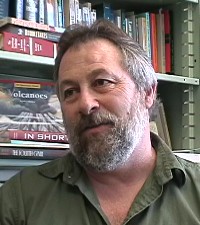 A former full-time freelance writer of essays and magazine and newspaper articles, John Calderazzo is professor of English at Colorado State University, where he teaches fiction and nonfiction writing workshops. He's the author of three books, Rising Fire: Volcanoes and our Inner Lives, 101 Questions About Volcanoes and Writing From Scratch: Freelancing. He writes about a wide variety of topics, including ecology, Asia, Buddhism and science. He also writes a natural history column called "Science and the Shore" for Coastal Living magazine.
A former full-time freelance writer of essays and magazine and newspaper articles, John Calderazzo is professor of English at Colorado State University, where he teaches fiction and nonfiction writing workshops. He's the author of three books, Rising Fire: Volcanoes and our Inner Lives, 101 Questions About Volcanoes and Writing From Scratch: Freelancing. He writes about a wide variety of topics, including ecology, Asia, Buddhism and science. He also writes a natural history column called "Science and the Shore" for Coastal Living magazine.
Rising Fire: Volcanoes and Our Inner Lives (2004, The Lyons Press)
101 Questions About Volcanoes (1994, Southwest Parks and Monuments Association)
Writing From Scratch: Freelancing (1990, Littlefield Adams Quality Paperbacks)
John Calderazzo's books can be purchased online at: http://www.tatteredcover.com/NASApp/store/
Rock moves. It moves all the time, everywhere, in big ways and small, through deep time and fast forward, on the surface of the earth and far below it. And in and around volcanoes, rock flies--at times faster and farther than any bird. Or it flows like tar, or water. It floats on water, burns on water. Glowing rock chunks the size of bowling balls bob and hiss in the south Pacific, the Gulf of Alaska, the Caribbean, the Mediterranean. Earth, Air, Fire, Water: the four classic elements that form the world, all jumbled up, none of them acting the way you think they should.
Over the long arc of time, volcanoes heave themselves up into high, holy mountains and haunted summits, burst apart, erode back down. Their lavas leap and turn with the grace of sandhill cranes in their mating dance; they breathe, roar, and sing. And singing, volcanic rocks and fires can deeply affect the way we see and act in the world, the stories we tell about the world.
A man who told many stories about the same volcano was the great Eighteenth Century artist Katsushika Hokusai. From the middle to the end of his long and prolific life, Hokusai created endlessly inventive perspectives on Mount Fuji, Japan's most sacred mountain. Among his 101 Views of Fuji is a woodblock print of a curving, luminous-orange slope of the volcano, rendered in such close-up that it fills half the sky. Other views include a perfect cone in the middle distance viewed through slanting arrows of rain over a lake; and a tiny, snow-tipped summit visible from sixty miles through the bustling cityscape of Edo, today's Tokyo. Fuji as dominating spirit. Fuji as one of many dynamic parts of nature. Fuji as a far off snow-dream to shopkeepers on a crowded street. So many Fujis and stories of Fuji!
And so many volcanoes around the world, about 500 that have erupted in historical time, perhaps 1300 that are potentially active--not counting hundreds more in our solar system. Each can be viewed in 101 ways: a channel through which the planet's rising fires move from inner to outer space, from sparks to stars; a source of the newest earth on earth; a doomsday machine monitored by satellites and seismographs; an inspiration to painters and writers. Of these "mountains alive," as volcanologist Maurice Krafft liked to call them, perhaps thirty to fifty are rumbling now. In all, about six hundred million people--one in ten on the planet--live in their shadows. Every one of us lives in their arc of influence. In ways that I had once never imagined, I know I do.